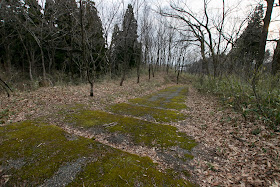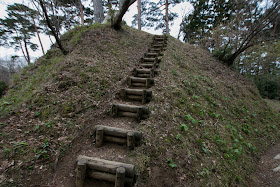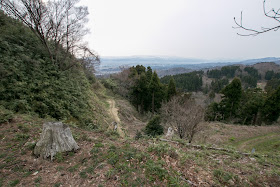Kasugayama Castle (1)
-Main base of "Dragon of Echigo"-
Overview
Name: Kasugayama Castle (Kasugayama-jo)
Alias:
Place: Nakayashiki Joetsu city, Niigata
Location: 37.147593752569115, 138.21161076586594
Type: Mountain Castle
Built: Originally 13th century, expanded in 16th century
Remnants: Gate, clay walls and moats
Title: 100 famous Japanese castles
Kasugayama castle (春日山城) is located over Kasugayama mountain, one of 180 meter height at the western hill area of central Joetsu city. Although placing at the western edge of Echigo province (Niigata prefecture), Joetsu area had been the center of Echigo province from ancient era and prospered with Naoetsu port which was regarded as one of the major ports in medieval era.
Due to its size and magnificence, Kasugayama castle is regarded as one of five largest medieval mountain castle along with Nanao castle (Ishikawa prefecture), Odani castle and Kannonji castle (Shiga prefecture), and Gassan Toda castle (Shimane prefecture).
Precise year is unknown, but it is said that Kasugayama castle was originally built by Uesugi clan as an evacuation place for the government office of Echigo country which located at the place of "Otate" residence in 14th century. Uesugi clan was originally a noble of Kyoto city, but in Kamakura era they moved to Kamakura city and became the feudal retainer of Kamakura Shogunate.
As Uesugi clan had marital relationship with Ashikaga clan, the founder of Muromachi Shogunate, thus in Muromachi era Uesugi clan became one of the highest retainer of Shogunate. Yamauchi Uesugi clan, the main stream of Uesugi clan, retained the name of Kanto Kanrei (general minister of Kanto region), and also held the governor of Kouzuke province (Gunma prefecture), Izu province (Izu peninsula) and Echigo province.
Type: Mountain Castle
Built: Originally 13th century, expanded in 16th century
Remnants: Gate, clay walls and moats
Title: 100 famous Japanese castles
Brief History
Kasugayama castle (春日山城) is located over Kasugayama mountain, one of 180 meter height at the western hill area of central Joetsu city. Although placing at the western edge of Echigo province (Niigata prefecture), Joetsu area had been the center of Echigo province from ancient era and prospered with Naoetsu port which was regarded as one of the major ports in medieval era.
Due to its size and magnificence, Kasugayama castle is regarded as one of five largest medieval mountain castle along with Nanao castle (Ishikawa prefecture), Odani castle and Kannonji castle (Shiga prefecture), and Gassan Toda castle (Shimane prefecture).
Uesugi clan and Nagao clan
Precise year is unknown, but it is said that Kasugayama castle was originally built by Uesugi clan as an evacuation place for the government office of Echigo country which located at the place of "Otate" residence in 14th century. Uesugi clan was originally a noble of Kyoto city, but in Kamakura era they moved to Kamakura city and became the feudal retainer of Kamakura Shogunate.
As Uesugi clan had marital relationship with Ashikaga clan, the founder of Muromachi Shogunate, thus in Muromachi era Uesugi clan became one of the highest retainer of Shogunate. Yamauchi Uesugi clan, the main stream of Uesugi clan, retained the name of Kanto Kanrei (general minister of Kanto region), and also held the governor of Kouzuke province (Gunma prefecture), Izu province (Izu peninsula) and Echigo province.
But due to the conflict with Ogigayatsu Uesugi clan which was originally same family at the latter half of 15th century, Yamanouchi Uesugi clan gradually lost their power and was finally replaced by Hojo clan, the uprising warlord of Sagami province (Kanagawa prefecture).
Uesugi clan appointed Nagao clan as the deputy governor of Echigo province. Nagao clan was originally a major branch family of Taira clan. As Nagao clan had relationship with Uesugi clan, they served the principle retainer or deputy governors under Uesugi clan.
Uesugi clan appointed Nagao clan as the deputy governor of Echigo province. Nagao clan was originally a major branch family of Taira clan. As Nagao clan had relationship with Uesugi clan, they served the principle retainer or deputy governors under Uesugi clan.
In Echigo province there were three major Nagao family, it means Fuchu Nagao clan, Ueda Nagao clan and Koshi Nagao clan, and among them Fuchu Nagao clan was the highest position. This Fuchu Nagao clan was the ancestor of famous Kenshin Uesugi (1530-1578, also called as Kagetora Nagao or Terutora Uesugi).
During 15th century Fuchu Nagao clan gradually expand their power, and in 1507 Tamekage Nagao (1489-1543), the leader of Fuchu Nagao clan and father of Kenshin, revolted to the governor Fusayoshi Uesugi (1474-1507) and forced him to suicide.
Upheaval of Nagao clan against Uesugi clan
During 15th century Fuchu Nagao clan gradually expand their power, and in 1507 Tamekage Nagao (1489-1543), the leader of Fuchu Nagao clan and father of Kenshin, revolted to the governor Fusayoshi Uesugi (1474-1507) and forced him to suicide.
Tamekage was once broken by counter attack of Akisada Uesugi (1454-1507), the main stream of Uesugi clan served Kanto Kanrei, but finally defeated Akisada and killed. Now Nagao clan became the warlord of Echigo province. This time Tamekage entered Kasugayama castle and used as residence of Nagao clan.
Tamekage continuously fought for expansion, but after his death his eldest son Harukage Nagao (1509-1553) was not good at military affairs and could not manage non obedient local lord in the country. Major local lords revolted to Nagao clan in cooperation with Ueda Nagao clan, and it became a crisis of Fuchu Nagao clan.
Among such situation, Kenshin Uesugi, originally named as Kagetora Nagao and who was he younger brother of Harukage, appeared into the stage. Kenshin grew at Rinsenji Temple at the hillside of Kasugayama mountain to become the monk, but Kenshin had interest in tactics from youth. After grow up, Kenshin became the general of Nagao clan and ordered by Harukage to suppress the revolts. Only with lesser troop Kenshin immediately beat revolted lords and won the reputation of genius of war.
Seeing the talent of Kenshin, some retainers of Harukage planned to replace their leader from Harukage to Kenshin. In 1548 Harukage finally leave the leader position to Kenshin and retired. Harukage Nagao (1526-1564), leader of Ueda Uesugi clan, was dissatisfied with this succession and rebelled, but under pressure from Kenshin finally Harukage subordinated to Kenshin in 1552 and the situation of Echigo country became stabilized.
Around this time, the situation surrounding Echigo country has significanlty changed. In 1552, Uesugi Norimasa (1523-1579), leader of Yamanouchi Uesugi clan and held Kanto Kanrei position, was defeated by Ujiyasu Hojyo (1515-1571) and escaped from Kanto region to Echigo province.
Tamekage continuously fought for expansion, but after his death his eldest son Harukage Nagao (1509-1553) was not good at military affairs and could not manage non obedient local lord in the country. Major local lords revolted to Nagao clan in cooperation with Ueda Nagao clan, and it became a crisis of Fuchu Nagao clan.
Appearance of Kenshin Uesugi
Among such situation, Kenshin Uesugi, originally named as Kagetora Nagao and who was he younger brother of Harukage, appeared into the stage. Kenshin grew at Rinsenji Temple at the hillside of Kasugayama mountain to become the monk, but Kenshin had interest in tactics from youth. After grow up, Kenshin became the general of Nagao clan and ordered by Harukage to suppress the revolts. Only with lesser troop Kenshin immediately beat revolted lords and won the reputation of genius of war.
Seeing the talent of Kenshin, some retainers of Harukage planned to replace their leader from Harukage to Kenshin. In 1548 Harukage finally leave the leader position to Kenshin and retired. Harukage Nagao (1526-1564), leader of Ueda Uesugi clan, was dissatisfied with this succession and rebelled, but under pressure from Kenshin finally Harukage subordinated to Kenshin in 1552 and the situation of Echigo country became stabilized.
Around this time, the situation surrounding Echigo country has significanlty changed. In 1552, Uesugi Norimasa (1523-1579), leader of Yamanouchi Uesugi clan and held Kanto Kanrei position, was defeated by Ujiyasu Hojyo (1515-1571) and escaped from Kanto region to Echigo province.
Additionally, Shingen Takeda (1521-1573), the warlord of Kai country (Yamanashi prefecture), expanded their territory to Shinano country (Nagano prefecture) and expelled Yoshikiyo Murakami (1501-1573), the strong local lord of Nagano area. Yoshikiyo also asked assistance to Kenshin.
Facing this situation, Kenshin who placed emphasis on the conservative order, assisted these old powers and struggled with Takeda clan and Uesugi clan. For Shinano country, Kenshin fought five consecutive battles at Kawanakajima (Nagano city) from 1553 to 1564.
Struggle against Takeda clan and Hojyo clan
Facing this situation, Kenshin who placed emphasis on the conservative order, assisted these old powers and struggled with Takeda clan and Uesugi clan. For Shinano country, Kenshin fought five consecutive battles at Kawanakajima (Nagano city) from 1553 to 1564.
At the fourth battle in 1561, Kenshin fiercely fought with Shingen and felled famous general of Takeda army including Nobushige Takeda (1525-1561), younger brother of Shingen and vice leader of Takeda clan. But in spite of tactical victory, Nagano area was finally captured by Shingen.
For Kanto region, in 1560, Kenshin started large scale expedition against Hojo clan. Kenshin rallied major warlords of Kanto region such as Satake clan or Satomi clan and local lords, and swept over Kanto region and siege Odawara castle, the main residence of Hojo clan, next year.
For Kanto region, in 1560, Kenshin started large scale expedition against Hojo clan. Kenshin rallied major warlords of Kanto region such as Satake clan or Satomi clan and local lords, and swept over Kanto region and siege Odawara castle, the main residence of Hojo clan, next year.
But due to the shortage of supply and dispute with subordinate lords, after one month siege Kenshin had to retreat his army. At this time, Kenshin succeeded Kanto Kanrei position from Norimasa Uesugi, and also became the adopted son of Norimasa. Now Kenshin had the sir name of Uesugi clan, and had the highest authority in Kanto region.
But Echigo country was far from Kanto region, and Kenshin could not make long expedition due to heavy snow. Looking at absence of Kenshin, Hojo clan gradually recovered their territory into north ward. Frequently Kenshin made expedition to Kanto region and achieved many tactical victories, thus Kenshin was called as "God of War". But he could not keep his achievement and gradually lost their influence in Kanto region. By around 1570, Kenshin lost Kanto region except for Kouzuke province before Hojo clan.
As grown in temple, Kenshin was an enthusiastic Buddhist, and especially believed in Vaisravana, one of the four guarding god which protect Buddha and regarded as god of war. It is said that Kenshin believed that he was the realm of Vaisravana, and prayed at the temple built at the top of Kasugayama castle before campaign. Facing with the battle. because of his tactical insight and braveness Kenshin made victory everywhere under the flag of Vaisravana. It is said that Kenshin did not suffer any defeat at field battle, even though there were even match or retreat from castle encirclement.
On the other hand, due to his fastidiousness, Kenshin was not good at plot and hated management of local lord. Once Kenshin felt disgusted for conflict between retainers, and suddenly run away to Koyasan temple, one of the famous sacred place of Japanese Buddhism but later returned by entreaties from retainers.
But Echigo country was far from Kanto region, and Kenshin could not make long expedition due to heavy snow. Looking at absence of Kenshin, Hojo clan gradually recovered their territory into north ward. Frequently Kenshin made expedition to Kanto region and achieved many tactical victories, thus Kenshin was called as "God of War". But he could not keep his achievement and gradually lost their influence in Kanto region. By around 1570, Kenshin lost Kanto region except for Kouzuke province before Hojo clan.
Strength and weakness of Kenshin
As grown in temple, Kenshin was an enthusiastic Buddhist, and especially believed in Vaisravana, one of the four guarding god which protect Buddha and regarded as god of war. It is said that Kenshin believed that he was the realm of Vaisravana, and prayed at the temple built at the top of Kasugayama castle before campaign. Facing with the battle. because of his tactical insight and braveness Kenshin made victory everywhere under the flag of Vaisravana. It is said that Kenshin did not suffer any defeat at field battle, even though there were even match or retreat from castle encirclement.
On the other hand, due to his fastidiousness, Kenshin was not good at plot and hated management of local lord. Once Kenshin felt disgusted for conflict between retainers, and suddenly run away to Koyasan temple, one of the famous sacred place of Japanese Buddhism but later returned by entreaties from retainers.
Further Kenshin did not marry considering precepts of Buddhism, but this lead internal conflict after the death of Kenshin (this fact became the cause of the story that Kenshin was actually the female). Due to his artistic character, Kenshin could not preserve results of his victory strategically. In 1570 Kenshin became monk (it was usually became a monk nominally for middle aged person in this era) and was called as his Buddhist name Kenshin hereafter.
Around 1570, the situation has changed again. His fatal rival Shingen Takeda and Ujiyasu Hojyo both died, and new ruler Nobunaga Oda (1534-1582) emerged in the central area. Kenshin at first allied with Nobunaga and expanded into Hokuriku region. Kenshin captured Ecchu province (Toyama prefecture) by 1575, and next attacked Nanao castle, the main castle of Noto country (north part of Ishikawa prefecture). After one year siege, Kenshin fell Nanao castle and seized Noto country in 1577.
Now territory of Kenshin directly faced with Oda territory. As commander of Nanao castle formerly asked assistance to Nobunaga, he sent his regional commander Katsuie Shibata (1522-1583). But Kenshin defeated Katsuie at the battle of Tedorigawa (Ishikawa prefecture) at that year, and was ready to advance to central area. Next year Kenshin planned large scale against Hojyo clan and mobilized his army, but just before expedition, Kenshin suddenly fell down and ended the 48 years life of continuous battles.
Due to his stoic character and invincible army, Kenshin was seen as the strongest warlord in Sengoku era and was praised as "God of War" or "Dragon of Echigo", and the struggle against Shingen is regarded as a good match of two rivals. Surely Kenshin was not good at plots, but this fact also increased his reputation and Shingen himself told his successor Katsuyori Takeda (1546-1582) to ally with Kenshin after his death.
Later years of Kenshin and death
Around 1570, the situation has changed again. His fatal rival Shingen Takeda and Ujiyasu Hojyo both died, and new ruler Nobunaga Oda (1534-1582) emerged in the central area. Kenshin at first allied with Nobunaga and expanded into Hokuriku region. Kenshin captured Ecchu province (Toyama prefecture) by 1575, and next attacked Nanao castle, the main castle of Noto country (north part of Ishikawa prefecture). After one year siege, Kenshin fell Nanao castle and seized Noto country in 1577.
Now territory of Kenshin directly faced with Oda territory. As commander of Nanao castle formerly asked assistance to Nobunaga, he sent his regional commander Katsuie Shibata (1522-1583). But Kenshin defeated Katsuie at the battle of Tedorigawa (Ishikawa prefecture) at that year, and was ready to advance to central area. Next year Kenshin planned large scale against Hojyo clan and mobilized his army, but just before expedition, Kenshin suddenly fell down and ended the 48 years life of continuous battles.
Due to his stoic character and invincible army, Kenshin was seen as the strongest warlord in Sengoku era and was praised as "God of War" or "Dragon of Echigo", and the struggle against Shingen is regarded as a good match of two rivals. Surely Kenshin was not good at plots, but this fact also increased his reputation and Shingen himself told his successor Katsuyori Takeda (1546-1582) to ally with Kenshin after his death.
Kenshin also admired authorities such as Emperor or Shogun, and was deeply trusted by them. Kenshin's stickiness to righteousness made only little reward at his period, but might contribute to the survival of Uesugi clan which faced many crisis at later period.
Continue to Part 2
Continue to Part 2





























































































































































































































































































































No comments:
Post a Comment